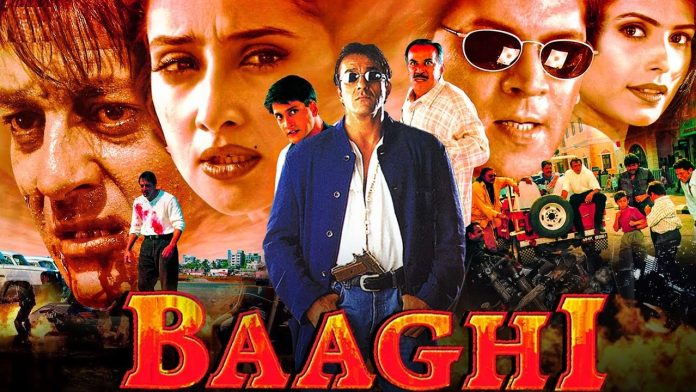BAAGHI
Triple Aar Movies’ Baaghi (A) is the usual don drama. A roadside don is so ferocious that he talks with his fist and guns at the drop of a hat. A professor, who comes to stay with his family in his locality, refuses to acknowledge the don’s might, but his little child develops a liking for him (the don). Much to the consternation of his father, the child befriends the don and grows up in his company. But the don loves the young boy like an elder brother would, and refuses to let him tread the path he (don) has adopted in life. The young boy falls in love with a very rich girl who is the sister of another dreaded don. Both the dons are great friends and although the young boy’s don-friend tries to make the other don agree to the alliance, the latter refuses as he has fixed his sister’s marriage with another guy. There is a battle of bullets and the young boy is nearly killed in it. Not only does his don-friend save his life but he also ensures that he gets his love. Ultimately, the two dons die in a blood-bath.
The film takes a fairly promising start as the child is shown being impressed by the don. The child’s defiance of his father also makes for interesting viewing. But the film degenerates into a routine drama once the child grows up into a young man. While the child and the don’s sister become adults, the two dons seemingly don’t grow old at all. Save in the initial reels, the screenplay has no place for police officers whatsoever. Screenplay is as commonplace as the story. Some dialogues are good but some others are unnecessarily flowery.
Sanjay Dutt does fairly well as the don and the doting friend. Manisha Koirala has no role to write about and is almost an extra in the film! Aditya Pancholi, as the other don, is alright. Indra Kumar plays the romantic hero and does an average job. Tina Senn is no heroine material. Shivaji Satam is supremely sincere as the upright and unbending professor. Master Rohan is brilliant. Sanjay Narvekar leaves a mark. Shama Deshpande, Gulshan Grover, Mohan Joshi, Mahesh Anand, Shalini Kapoor, Aroon Bakshi, Dinesh Hingoo, Rana Jung Bahadur, Tej Sapru, Dipen Vartak, Jack Gaud, Gavin and the rest lend average support.
Rajesh Kumar Singh’s direction is dull although it shows sparks in the first few reels. Music (Sajid Wajid) is a letdown. Song picturisations are ordinary. Camerawork is so-so. Production values are average.
On the whole, Baaghi is a poor drama.
Released on 7-4-2000 at Novelty and 23 other cinemas of Bombay thru Dilsa Distributors. Publicity & opening: dull. …….Also released all over. Opening was poor almost everywhere.
LATEST POSITION
With examinations coming to an end, the box-office is in dire need of new releases which have merits.
Hera Pheri has done well in Maharashtra and Nizam but is very poor elsewhere. 1st week Bombay 52,62,036 (77.30%) from 12 cinemas (6 on F.H.); Ahmedabad 12,47,993 from 5 cinemas, Rajkot 2,20,547; Pune 14,25,769 from 5 cinemas (1 in matinee), Solapur 2,73,804 from 2 cinemas (1 in matinee), Satara 1,36,586; Delhi 37,94,547 (47.88%) from 12 cinemas (2 on F.H.); Kanpur 2,52,679 from 2 cinemas, Lucknow 4,16,784, Agra 2,32,000, Allahabad 1,31,421, Bareilly 99,849, Hardwar 60,000; Calcutta 11,03,898 from 9 cinemas (1 in noon); Nagpur 5,11,372 from 2 cinemas, Jabalpur (6 days) 62,173, Akola 1,74,505, Raipur (gross, 6 days) 2,45,489, Jalgaon 1,92,200; Indore 2,40,103 from 2 cinemas (3 on F.H.), Bhopal 2,82,157 from 2 cinemas; Jaipur 5,55,007 from 3 cinemas, Bikaner 1,61,409; Hyderabad (gross) 27,57,318 from 12 cinemas (1 in noon, 1 on F.H.), share including Aurangabad 19 lakh.
…………
Dulhan Hum Le Jayenge drops further, but is fairly good in Bombay and parts of Maharashtra. 2nd week Bombay 37,13,950 (86.13%) from 10 cinemas (9 on F.H.); Ahmedabad 17,54,294 from 8 cinemas, Rajkot 1,81,000, Jamnagar 91,349; Pune 9,90,769 from 6 cinemas (1 in matinee), Solapur 2,15,272, Satara 1,32,257 from 2 cinemas (1 in matinee); Bijapur 1,12,544; Delhi 46,70,860 from 12 cinemas (1 on F.H.); Kanpur 3,37,830 from 2 cinemas, Lucknow 4,69,212, Agra 2,45,000, Allahabad 1,97,000, Hardwar 50,000; Calcutta 7,79,436 from 3 cinemas; Nagpur 3,37,018 from 3 cinemas, Jabalpur (6 days) 1,54,229, Akola 1,20,500 (1st 2,30,000), Raipur (6 days) 89,734, Jalgaon (6 days) 81,000, Wardha 46,807, Chandrapur 83,083, 1st week Yavatmal 1,82,197; Bhopal 73,741; 2nd week Jaipur 6,30,069, Bikaner 1,80,130; Hyderabad (gross) 12,20,121 from 5 cinemas (1 on F.H.).
Kaho Naa…Pyaar Hai 12th week Bombay 21,47,829 (64.71%) from 8 cinemas (7 on F.H.); Ahmedabad 3,89,743 from 3 cinemas, Baroda 2,15,286, 12 weeks’ total in Rajkot about 17,00,000; 12th Pune 6,75,212 from 4 cinemas (1 in matinee), Solapur 1,45,387, 1st week Barsi 82,070, 10th Satara 1,17,449 from 2 cinemas (1 in matinee); 12th week Dharwad 51,286; Delhi 9,81,415 from 7 cinemas; Kanpur 1,29,918 from 2 cinemas, Lucknow 2,78,014, Agra 1,06,000, Allahabad 63,376, Bareilly (6 days) 37,964; Calcutta 7,43,654 from 4 cinemas; Nagpur 1,83,546 from 2 cinemas, Jabalpur 84,733, total 17,11,498, 5th week Balaghat 37,504, total 3,21,764, 12th week Amravati 89,331, Akola 92,491 (11th 87,224), total 16,09,052, Raipur 78,160, Jalgaon 80,039, 7th Wardha 44,200, 11th week Chandrapur 76,785, total 17,38,870, 10th week Yavatmal 55,687; 12th week Bhopal 1,19,793; Jaipur 1,58,712; Hyderabad (gross) 6,84,210 from 3 cinemas (1 in noon, 4 on F.H.).
Mahiyar Ni Maya (Gujarati; TF) 1st week Ahmedabad 2,36,354 from 4 cinemas.
Navra Mumbaicha (Marathi; TF) 1st week Bombay about 1,00,000 (60.23%).
Split Wide Open (English; partly in Hindi) is dull. 1st week Bombay 8,35,797 from 8 cinemas; Calcutta 1,54,909.
VINOD RATHOD BEREAVED
Poornima, wife of playback singer Vinod Rathod, expired on the morning of 6th April at her residence in Bombay, reportedly due to depression. She was 39.
A.P. CINEMA BANDH PARTIAL
Most of the cinemas in Andhra Pradesh remained closed on 5th April in response to a bandh call given by various film chambers of commerce seeking total exemption of entertainment tax for locally-made films and tax concessions for films produced outside Andhra Pradesh.
The associations had earlier decided to go on an indefinite strike but it was later decided to restrict it to a one-day strike. The strike was almost total in Nizam and Ceded areas. Only a few cinemas in Hyderabad, showing Hindi films, were functioning on the day of the strike. The Andhra region, however, did not participate in the one-day strike.
KETAN, VIVEK ANAND REMANDED TO POLICE CUSTODY
Late filmmaker Chetan Anand’s sons, Ketan and Vivek, who were arrested by the Bombay police on the night of 4th April in connection with the murder of former actress Priya Rajvansh, were produced before metropolitan magistrate P.P. Shiroshe of the Bandra holiday court, Bombay, on 5th April. The Anand brothers were remanded to police custody till 10th April. Two other accused, the maid servant, Mala Choudhary, and her accomplice, Ashokan Swami, were also remanded to police custody. The accused have been charged with conspiracy and murder.
Priya Rajvansh, who was a close friend of Chetan Anand, had died in mysterious circumstances on 28th March in the Ruia Park (Juhu, Bombay) bungalow of the Anands. Her funeral was held on 6th April.
NEW KOHINOOR CINEMA IN JODHPUR INAUGURATED
A new cinema, New Kohinoor Upper, was inaugurated on 1st April in Jodhpur at the hands of the Rajasthan Housing Board president, Man Singh Deora. City MLA Jugal Kabra and Bhanwar Bali of Sur Sagar were the chief guests at the function. The cinema is owned by Noor Mohammed.
RAJASTHAN TRADE TO OBSERVE DAY’S CLOSURE IN PROTEST AGAINST NEW FORMULA FOR ENT. TAX
A meeting of the Rajasthan film trade, convened by the Central Circuit Cine Association (CCCA) on 7th April in Jaipur, decided to observe a day’s token strike on 20th April if the state government did not withdraw the new formula of calculating the minimum entertainment tax at 25% on capacities of cinemas. The new tax, calculated at a minimum of 25% of the capacity per show (and not per day or week), came into effect from 1st April, 2000. CCCA president Santosh Singh Jain presided over the meeting held behind Moti Mahal cinema. Surendra Kumar Golechha, Kushal Chand Surana, CCCA executive committee members Trilok Singh, N.K. Jalani and Kishanchand Jain attended the meeting. Kishan Chand Janiani and Ramdhan Mamoria organised the meeting alongwith others.
In the meantime, writ petitions against the new tax have been filed in the Rajasthan high court on behalf of Samrat cinema, Jaipur and Ajanta cinema, Ajmer. While the former writ will come up for hearing on 10th April, that of Ajanta cinema will come up for hearing the following day (11th April).
As far as the cinema closure goes, the opinion in the Rajasthan trade was divided. While some wanted an indefinite closure of cinemas across the state, there were others who felt a token strike would suffice.
YOU ASKED IT
Does it make a difference if a hero distributes a film starring himself?
– To a small extent, it does make a difference among the exhibition community. There is something known as star charisma. As far as the public is concerned, it doesn’t make any difference.
What do you think of so many producers floating public issues in the forthcoming months?
– Public sentiments for media and entertainment companies are high, so producers want to ride on that wave. Like our films, in public issues too, 20-25% of the producers will succeed, others won’t.
Does a new hero click when people are tired/bored of the existing ones or do people get bored of the existing heroes when a new hero clicks?
– This is like asking me, what came first — the hen or the egg?
3-E
Education-Entertainment-Enlightenment
Endangered In Africa
One is filled with dread as one reads the pathetic and frightening state which cinemas in Nairobi have been reduced to. A 12-column report in a Nairobi daily, Daily Nation, reveals the following hard facts:
Embassy cinema, Nairobi, which has 850 seats, hardly attracts 5 people a day!
Another cinema, Nairobi Cinema, attracts only 20 to 30 per cent of its 850-seat capacity. This, despite the cinema having the largest screen in East Africa and being equipped with Dolby Digital sound system.
Sun City and Eastlands cinemas, which are video cinemas, offer 6 films on one ticket. But there are hardly any buyers!
Fox Drive-In and Kenya Cinema are on the verge of closure. …..Almost all East African cinemas tell the same sad story.
Many Nairobi cinema-owners are letting out their cinemas to churches on Sundays. Globe, Shan and Rainbow cinemas have been turned into churches!
The reasons for such a depressing state of affairs are: failure of the government to crack down on abusers of Copyright Act; crime and insecurity in the areas neighbouring the cinemas; poor economy; screening of new films by television and video outlets, showing of contraband films on the licensed cable TV channels….. Is the situation not quite similar here at home? It would be better to take stock of the scene in our country and take corrective action before India goes the East African way!
Jaldi Kar Di Aapne
The dances of Govinda in Hadh Kar Di Aapne once again prove that he is the best dancing hero the industry has. The grace with which the guy dances cannot be matched by any other hero. That apart, Rani Mukerji’s matching panache, Anand Raaj Anand’s music, and the song picturisations are also very good. In fact, the songs are so nice that one really feels, their popularity today does not match their potential. Despite T-Series doing a good job of the television publicity of the film, the songs have not reached the peak of their popularity for whatever reason. Producers Rajeev Anand and Rakesh Malhotra and director Manoj Agarwal would surely find solace in the fact that their songs are immensely likeable, but one surely feels, they have hurried up with the release. April 14 is almost around the corner. A release at least three weeks from now would have been more desirable because the catchy songs would’ve got more time to get popular before the film hit the screens. That would have ensured on opening better than what the film can now hope to get. A little bit of jaldbaazi, this!
INFORMATION MEETS
“The basic concept of filmmakers in Bombay is wrong!”
– R. MOHAN
Dr. SHIVAJI SEN-GUPTA
Sometimes our actions are not answers but questions. And it was with numerous questions that a young electrical engineer from Trichy, R. Mohan, came to Bombay in 1974. The answers came slowly and anything but easily. After working for companies like Kotak and Batliboi for around 3 years, followed by a stint of trading independently, he turned into an entrepreneur by setting up a modest plant at Vasai. It took him another three years to launch ‘Good Knight’, a pioneer in mosquito repellents, in the market. The Good Knight coil more than lived up to its name and Mohan was quick to market an entirely different product — Snuggies (diapers for babies) and this, too, was a runaway success. The answers had — well, more or less — all fallen into place for the man brought up in a typical middle-class family and fifth in the hierarchy of seven siblings.
His next foray took many by surprise. He made a Malayalam film, Isabelle (1987), on a modest scale but his tally at present is impressive by any count. Thirty-two films in Malayalam, 2 in Tamil, 2 in Hindi with several in each language either waiting for release or under-production.
Excerpts from our conversation:
I recall first meeting you at a special screening of WAHEM in the mid-’80s at Hotel SeaRock where ‘Good Knight’ mats and machines were being given as complimentaries to all invitees. How were you involved in this particular film?
– Well, I was not involved as such in Wahem! But I did get an opportunity to dabble with the medium at close quarters. Further, my primary motive was to promote my product ‘Good Knight’ through imaginative in-film advertising. In fact, along with the neon signs and hoardings of ‘Good Knight’, it was pretty deftly woven into the plot as well. It was a pity that the film of A.V. Mohan was not successful! I spent around Rs. 4-5 lakh on this.
What made you enter this line in the first place? Was it the financial cushion provided by ‘Good Knight’ by any chance?!
– No no, not at all. If this was to be the criterion, then the house of Tatas would have been the leading producers. A strong inclination, a taste for the fine arts must be there within you. I recall seeing not less than 400 films per year during my college days. Also, I remember my passion to become an actor in my youth. Indeed, me and some of my friends had run away to Madras in pursuit of this nascent dream! Mercifully, this phase was short-lived, it died a natural death. Nowadays, I don’t feel like essaying even a small role in my own films! Incidentally, I was one of the first to predict that the corporate sector will enter the arena of entertainment.
Can you enlighten us about the business trends in Malayalam cinema and how they differ from Hindi cinema?
– The strange aspect about Malayalam films is that the entire financial burden has to be shouldered by the producer. There is no MG royalty system. The distributors release films only on commission basis. If the film is a hit, the producer hits the ceiling, but if it is a flop, then he is drowned.
Even in the exhibition sector, things are different. Exhibitors follow what is known as a daily holdover system. If a film is not able to register collection up to the level fixed by the exhibitor, then the theatre owner can legally discontinue your film and replace it with some other.
As we all know, there is a large expatriate population of Malayalees all over the world in general and in the UAE in particular. How much is it possible for a producer to recover from the Gulf?
– It depends largely on the star cast of a film. If one has a Mohanlal or a Mammootty starrer, then Rs. 15 lakh is easy to get. To put it in a nutshell, the range is from Rs. 5-15 lakh. For a non-star cast film, one can expect Rs. 5 lakh, and for an average star cast film, Rs. 10 lakh. Considering that the average cost of making a film with Mohanlal or Mammootty is in the region of Rs. 2-2.5 crore and even an average film costs around Rs. 75 lakh to 1 crore to make, this amount that one recovers from the Gulf is not particularly significant. All the more, since the distributor in the Gulf markets the film all over the world through video cassettes, VCDs, LDs or DVDs or whatever!
What about satellite rights and Doordarshan’s Movie Club — are they attractive alternatives?
– The market for satellite rights has been rising and I feel that it will soon be equivalent to one territory. Asianet and Surya TV are the leading satellite channels in Malayalam. Asianet is, without doubt, the most popular channel with the largest viewership. In the initial stages, I used to get around Rs. 1-2 lakh per film from Asianet but today, I am offered anything in the region of Rs. 10 to 15 lakh. Again, the star cast does play a role in determining the price. Yet, though I have made many films with Mohanlal and Mammootty, I also made 2 films with fresh faces, which became runaway hits.
Surprisingly, in Tamil cinema, although there is respite in film distribution — distributors there buy films on MG royalty basis — the TV channels do not offer as much as the Malayalam ones. I really can’t understand this!
Since you are active in regional and Hindi films, what are the major differences that strike you?
– The basic concept of filmmakers in Bombay is wrong! They are more concerned about booking the dates of a star and then weaving a story around him. In the South, we first sit on the story for 4-5 months. Then and only then do we decide on the stars. That is the reason why film production in the South is not only more disciplined but also of superior quality.
Reams have been written on the delay in completing RAJA KO RANI SE PYAR HO GAYA. How has it shaped up, in your opinion? Also, what are the other projects on the anvil?
– While making Raja Ko Rani Se Pyar Ho Gaya, I encountered a unique superstar — a baby elephant. There were times when the entire unit would sit twiddling their thumbs waiting for the elephant to wake up! I have a feeling that this film will run. I have noticed that films with animals in pivotal roles always go down well with the audience. And the film is well-made and engaging — the delays have not affected the end result. Besides, promotion and publicity, I believe, do make a noticeable difference.
I am very excited about my next two projects. The first is titled Pagalpan and has a fresh star cast — Rakesh Nath’s (Rikku’s) son is the hero, and a girl from America, called Aarti, is the heroine. The director is Joy Augustine, the maker of ABCL’s Tere Mere Sapne. Once I complete Pagalpan, I have a fascinating subject about the girls working in the beer bars of Bombay. Tabu palys a stellar role, and this film — we have not yet finalised the title — is being directed by Madhur Bhandarkar, an associate of Ram Gopal Varma.
I am very ambitious about this film and I intend entering it in every major film festival all over the world. Atul Kulkarni plays an interesting role in it. I intend starting it by July — subject to Tabu’s dates being available. I have a hunch, this will be a landmark film in Tabu’s already distinguished career!
I must not fail to mention that I have bought the rights of a fantasy film for children as the target audience. The next year promises to be a rather eventful one for me.
A few years ago, you had launched a company to make software for television and before one could say “Jack Robinson”, the project had vanished! Are your sights set solely on the big screen?
– Not quite. I do agree that I had started Shogun Enterprises and shelved it, but now, I have plans of reviving it in a big way. I plan to make software only in Hindi for leading channels like Zee, Sony, Star Plus etc. I must lay stress on one aspect. I am open to new talent, fresh talent, discarded talent and what have you, as long as they are armed with novel ideas and subjects. And this applies as much to my TV serials as to my films.
Finally, an observation. Is there an inherent streak of violence hidden in your personality — first, Good Knight, and then, Shogun. Quite a curious choice of names for your banners, wouldn’t you agree?
– I agree, I agree. But when you become successful, there are friends and well-wishers who start making you believe in certain things which, according to them, are lucky mascots. I was advised that ‘Knight’ is a warrior in the West and my next banner should be named after a warrior from the East. Hence we decided on the name ‘Shogun’. These are minor compromises that one has to make in business.
For instance, although I am still addressed by the press as ‘Good Knight’ Mohan, the fact is, I have sold ‘Good Knight’ to Godrej. A lot of people ask me if I was emotionally disturbed in parting with my baby. Well, all I can say in reply is that there is really no room for emotions in business!





























